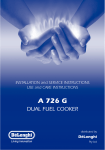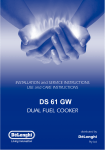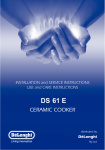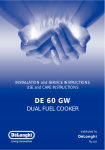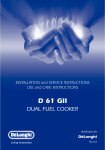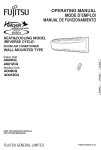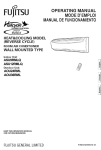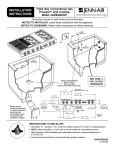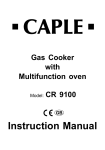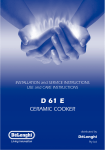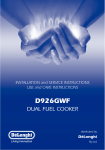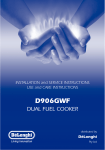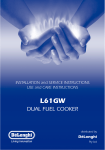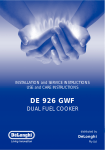Download DeLonghi D 90 G Specifications
Transcript
D 90 G Professional COOKER INSTALLATION and SERVICE INSTRUCTIONS USE and CARE INSTRUCTIONS distributed by PA R E X Industries Ltd Dear Customer, Thank you for having purchased and given your preference to our product. The safety precautions and recommendations reported below are for your own safety and that of others. They will also provide a means by which to make full use of the features offered by your appliance. Please keep this booklet in a safe place. It may be useful in future, either to yourself or to others in the event that doubts should arise relating to its operation. This appliance must be used only for the task it has explicitly been designed for, that is for cooking foodstuffs. Any other form of usage is to be considered as inappropriate and therefore dangerous. The manufacturer declines all responsibility in the event of damage caused by improper, incorrect or illogical use of the appliance or be faulty installation. PRODUCT LABEL 2 FIRST TIME USE THE OVEN It is advised to follow these instructions: Clean the interior of the oven with cloth soaked in water and detergent (neutral) then dry carefully. ■ Fit the wire racks as described at chapter “Use and care”. ■ Insert shelves and tray. ■ Switch on the empty oven on max to eliminate grease tracks from the heating elements. ■ IMPORTANT PRECAUTIONS AND RECOMMENDATIONS FOR USE OF ELECTRICAL APPLIANCES Use of any electrical appliance implies the necessity to follow a series of fundamental rules. In particular: ■ Never touch the appliance with wet hands or feet; ■ do not operate the appliance barefooted; do not allow children or other incapable people to use the appliance without supervision. The manufacturer cannot be held responsible for any damages caused by improper, incorrect or illogical use of the appliance. ■ 3 IMPORTANT PRECAUTIONS AND RECOMMENDATIONS After having unpacked the appliance, check to ensure that it is not damaged. In case of doubt, do not use it and consult your supplier or a professionally qualified technician. Packing elements (i.e. plastic bags, polystyrene foam, nails, packing straps, etc.) should not be left around within easy reach of children, as these may cause serious injuries. 4 ■ Do not attempt to modify the technical characteristics of the appliance as this may become dangerous to use. ■ Do not carry out cleaning or maintenance operations on the appliance without having previously disconnected it from the electric power supply. ■ After use, ensure that the knobs are in off position. ■ Do not allow children or other incapable people to use the appliance without supervision. ■ During and after use of the cooker, certain parts will become very hot. Do not touch hot parts. ■ Keep children away from the cooker when it is in use. ■ Some appliances are supplied with a protective film on steel and aluminium parts. This film must be removed before using the appliance. ■ Fire risk! Do not store flammable material in the oven, and in the accessory drawer. ■ Make sure that electrical cables connecting other appliances in the proximity of the cooker cannot come into contact with the hob or become entrapped in the oven door. ■ Do not line the oven walls with aluminium foil. Do not place baking trays or the drip tray on the base of the oven chamber. ■ The manufacturer declines all liability for injury to persons or damage to property caused by incorrect or improper use of the appliance. ■ IMPORTANT NOTE: This appliance shall not be used as a space heater, expecially if installed in marine craft or caravans. INSTALLATION CAUTION: ■ This appliance must be installed in accordance with these installation instructions, local gas fitting regulations, municipal building codes, water supply regulations, electrical wiring regulations, AS5601 / AG 601 - Gas Installations and ony other relevant statutory regulations. ■ This appliance shall be only be serviced by authorized personnel. ■ This appliance is to be installed only by an authorised person. ■ Incorrect installation, for which the manufacturer accepts no responsibility, may cause personal injury of damage. ■ Always disconnect the cooker from mains power supply before carrying out any maintenance operations or repairs. ■ In the room where the cooker is installed, there must be enough air to allow the gas to burn correctly, according to the current local regulations. 5 ELECTRICAL REQUIREMENTS ■ ■ ■ ■ ■ ■ ■ The appliance must be connected to the mains checking that the voltage corresponds to the value given in the rating plate and that the electrical cable sections can withstand the load specified on the plate. The plug must be connected to an earthed socket in compliance with safety standards. If the appliance is supplied without plug, fit a standard plug which is suitable for the power consumed by the appliance. The appliance must be connected directly to the mains placing an omnipolar switch with minimum opening between the contacts of 3 mm between the appliance and the mains. The power supply cable must not touch the hot parts and must be positioned so that it does not exceed 50°C above ambient. Once the appliance has been installed, the switch or socket must always be accessible. If the power supply cable is damaged it must be substituted by a suitable cable according to current electrical regulations. N.B. The connection of the appliance to earth is mandatory. If the installation requires alterations to the domestic electrical system call a qualified electrician. He should also check that the socket cable section is suitable for the power drawn by the appliance. Replacing the power cord must be done by a qualified electrician in accordance with the instructions supplied by the manufacturer and in compliance with established electrical regulations. 6 CLEARANCES Installation clearances and protection of combustible surfaces shall comply with the requirements of AS5601 / AG 601 - Gas installation. Installation shall comply with the Dimension in Fig 1 bearing in mind that Overhead Clearances In no case shall the clearances between the highest part of the cooker be less than 600mm or for an ovehead exhaust fan 750mm. AII other downward facing combustible surfaces less than 600mm above the cooker surface shall be protected for the full width of the cooking surface in accondance with the standards noted above. In no case shall the clearance be less than 450mm Side Clearances Where the dimensions from the periphery of the nearest burner to any vertical combustible surface is less than 200mm the surface shall be protected in accordance with the standards to a height of not less than 150mm above the cooking surface for the full width or depth of the cooking surface Protection of combustible surfaces. The standards above specify that where required protection shall ensure that the surface temperature of the combustible surface does not exceed 50°C above room temperature. 500 mm 450 mm 650 mm Figure 1 300 mm 7 ANTI-TILT BRACKET Fixing the anti-tilt bracket: ■ After you have located where the cooker is to be positioned mark, on the wall, the place where the 2 screws of the anti-tilt bracket have to be fitted. Please follow the indications given in the drawing below. ■ Make two holes of diameter 8mm diameter on the wall and insert the plastic plugs. ■ Attach the anti-tilt bracket loosely by means of 2 screws. ■ Move the cooker to the wall and adjust the height of the anti-tilt bracket so that it can engage in one slot of the cooker back. ■ Attach the anti-tilt bracket tight. ■ Push the cooker against the wall so that the anti-tilt bracket is fully inserted in one slot of the cooker back. Figure 2 = 8 = ASSEMBLING THE BACKGUARD 1. Insert the side supports S and D into the backguard B (see fig. 3) 2. Insert the backguard group into the support guides in the cooker 3. The backguard can be removed for cleaning or fixed with a screw through the hole C. D B S C Identification label Figure 3 When you open the bottom oven door the indentification label is at the bottom right hand side. 9 USE and CARE CAUTION: ■ This appliance must be used only for the task it has explicitly been designed for, that is for cooking foodstuffs. Any other form of usage is to be considered as inappropriate and therefore dangerous. ■ Do NOT place combustible materials or products on this appliance at any time. ■ Do NOT spray aerosols in the vicinity of this appliance while it is in use. USING THE OVEN FOR THE FIRST TIME Clean the inside of the oven with a cloth soaked in water and neutral detergent and dry thoroughly. ■ Slide in the catalytic liners and wire racks on the oven wall as in Fig. 4. Position the shelf and tray as per Fig. 5. ■ ■ To eliminate traces of grease in manifacture it is necessary to pre-heat the oven at the maximum temperature, for 60 minutes in the position, for 30 minutes in the position and for another 15 minutes in the position. Figure 4 10 Figure 5 GAS SUPPLY: ■ The connection must be executed by an authorised person according to the relevant standards. ■ Before connecting the appliance to the gas main, mount the brass conical adaptor onto the gas inlet pipe, upon which the gasket has been placed (figures 6-7). Conical adaptor and gasket are supplied with the appliance (packed with conversion kit for use with Natural gas or LPG). ■ This appliance is suitable for use with Natural Gas or LPG. (Check the “gas type” sticker attached to the appliance). ■ For Natural Gas models the gas supply is connected to the pressure regulator which is supplied with the appliance. Adjust the regulator to obtain a test point pressure of 1 kPa with the two largest burners operating. ■ For LPG models connect the gas supply directly to the appliance inlet connection and ensure that the supply pressure is regulated to 2.75 kPa. ■ The connection must be made at the rear of appliance (left or right); the pipe do not cross the cooker. ■ The terminal not used must be closed off with the plug and gasket supplied. ■ IMPORTANT: To screw the connecting tube operate with 2 spanners (side figure 9). Figure 6 Figure 7 Gas connection for LPG Gas connection for NATURAL GAS Gas inlet pipe Gas inlet pipe Nipple Nipple Gasket Gasket Brass conical adaptor Brass conical adaptor (Thread tight: use suitable seal) (Thread tight: use suitable seal) Gas regulator 11 1. After connecting the gas supply, check the piping and connections for leaks using a soap and water solution. The presence of bubbles indicates a leak, tighten or replace connections as appropriate. 2. Adjust the test point pressure or supply pressure to the value which is appropriate for the gas type. 3. The operation of the appliance must be tested before leaving. 4. Turn on the appliance gas controls and light each burner individually and in combination. Check for a well defined blue flame without any yellow tipping. If any abnormality is evident then check that the burner cap is located properly and the injector nipple is aligned correctly. 5. Check the minimum burner setting by quickly rotating the gas control knob from the maximum to the minimum position, the flame must not go out. If adjustment is required carry out the “minimum burner setting adjustment" procedure described 6. If satisfacfory performance cannot be obtained isolate the appliance and contact the local gas authority for advice and assistance. Figure 8 Figure 9 Plug 12 INJECTORS REPLACEMENT This appliance is suitable for use with natural gas or LPG (check the “gas type” sticker attached to the appliance). A label stating the type of gas used after replacing the injectors should replace the existing label. The nominal gas consumption and injector size details are provided in table at page 18. To replace the injectors it is necessary to lift the cooktop and proceed as follows: ■ Remove the backguard “E” (Fig. 10). ■ Remove pan supports and burners from the cooktop. ■ Unscrew the two screws “B” and remove the sockets (Fig. 10). ■ Unscrew the two screws “C” and remove the two side trims and joints pulling upwards. ■ Pull forwards the hobtop to release it, then lift following arrow “D” (Fig. 10). ■ Hold the hobtop open by a support. ■ Fully raise the adjusting air tube A (fig. 11) in order to easily reach the injector. ■ Using a 7 mm A/F angled spanner, remove the injector from its housing and replace it one according to the kind of gas (see following tables - page 16). Figure 10 G B V E D B E D 13 PRIMARY AIR ADJUSTMENT OF THE BURNERS By operating the screw “M”, reset the air adjuster “A” according to the instructions see “Injector table”, where the distance between injector and air adjuster is recommended (in mm). Before refixing the hob top, set the burners on their sites and light them in order to check whether the flames are correct, as per the specifications given above. In case of uncorrect flame, lift or lower the air adjuster. Figure 11 M J A Flame faulty in primary air Flame correct Flame with excess primary air long, yellow and trembling clear interior blue cone short and sharp too blue interior cone tending to detach CAUSE air regulating tube, too closed 14 correct distance of the tube air regulating tube, too open MINIMUM BURNER SETTING ADJUSTMENT In the minimum position the flame must have a length of about 4 mm and must remain lit even when turned quickly from the maximum position to minimum. The flame adjustment is done in the following way: ■ Turn on the burner ■ Tum the tap to the MINIMUM position ■ Take off the knob ■ With a small flat screwdriver turn the screw “F” (fig. 12) to the correct regulation. Normally for LPG, the regulation screw is tightened up fully. Figure 12 F 15 TABLE FOR THE CHOICE OF THE INJECTORS Test Point Pressure [kPa] Natural gas Propane 1,0 2,75 kW kW mm Primary air shutter opening [mm] mm Primary air shutter opening [mm] Auxiliary (A) 0,9 0,25 0,83 1 0,5 3 Semi-rapid (SR) 1,7 0,44 1,15 4 0,67 6 Double ring (DR) 3,4 0,85 1,6 15 0,92 Fully open Fish burner (FB) N = 2,8 LPG = 3,06 0,85 1,42 15 0,90 Fully open Nominal Power BURNER INCREASE BURNERS Reduced power Injector Orifice Dia. OF AIR NECESSARY FOR GAS COMBUSTION Injector Orifice Dia. (2 m3/h x kW) Air necessary for combustion [m3/h] Auxiliary (A) 2,00 Semi-rapid (SR) 3,80 Double ring (DR) 6,90 Fish burner (FB) 7,10 LUBRICATION OF THE GAS TAPS If the gas tap becomes stiff, it is necessary to dismantle it carefully and clean it with petroleum spirit. Specialist high temperature resistant grease should be used to lubricate the tap before replacing. The operations must be carried out by an authorised person. 16 GAS HOB Figure 13 2 3 4 1 GAS BURNERS 1. 2. 3. 4. 5. Double ring burner (DR) Semi-rapid burner (SR) Fish-burner (FB) Semi-rapid burner (SR) Auxiliary burner (A) 5 Natural Gas Mj/hr Propane Mj/hr 12,2 6,1 10,1 6,1 3,0 10,8 5,6 11,0 5,6 3,1 17 LIGHTING GAS BURNERS FITTED WITH SAFETY VALVE DEVICE AND ELECTRONIC IGNITION ■ Check that the electricity is switched on to allow spark ignition. ■ Make sure that all controls are turned to zero. ■ The gas flow to the burner is controlled by a taps with safety valve device. If the burner flame should go out for some reason, the safety valve will automatically stop the gas flow. The switch of the electric ignition is incorporated in the knobs. Figure 14 ■ You control the flow by turning the knob indicator to line up with the following symbols: – Symbol 18 ● : tap closed (burner off) – Symbol : High (maximum) – Symbol : Low (minimum) ■ To ignite automatically, simply push the required knob down and turn it to maximum, keep the knob down until the burner lights. When the flame is lit, wait for about ten second with the knob down (safety valve activation delay). ■ You can control the temperature by the knob to “full on” from “reduced rate”. ■ To switch off, turn the knob clockwise until you hear the safety click. ■ Note that, if you are using a burner at the minimum setting, you turn the knob clockwise past the maximum setting before reaching the off position. ■ Whenever the lighting of the burners will result difficult due to peculiar conditions. If when lighting any of the burners an anormal flame appears, switch that the burner off and relight using the minimum setting. ■ If the flame is still different from normal, turn the burner off and consult your DeLonghi service agent. ■ In the case of a mains failure light the burner with a match or lighted taper. CHOICE OF BURNER The burner must be chosen according to the diameter of the pans and energy required. Burners Pan diameter Auxiliary Semi-rapid Double ring Fish-burner Wok 16 cm 16 to 22 cm up to 30 cm from 12x30 to 18x40 cm max 36 cm Figure 15 Saucepans with handles which are excessively heavy, in relationship to the weight of the pan, are safer as they are less likely to tip. Pans which are positioned centrally on burners are more stable than those which are offset. It is far safer to position the pan handles in such a way that they cannot be accidentally knocked. When deep fat frying fill the pan only one third full of oil. DO NOT cover the pan with a lid and DO NOT leave the pan unattended. In the unfortunate event of a fire, leave the pan where it is and turn off all controls. Place a damp cloth or correct fitting lid over the pan to smother the flames. DO NOT use water on the fire. Leave the pan to cool for at least 30 minutes. 19 CORRECT USE OF DOUBLE-RING BURNER 20 ■ The flat-bottomed pans are to be placed directly onto the pan-support. ■ To use the WOK you need to place the proper stand in order to avoid any faulty operation of the wok burner. Figure 16 Figure 17 WRONG CORRECT MULTIFUNCTION OVEN Figure 18 A U T O 1 2 3 4 5 7 8 9 10 CONTROL PANEL - Controls description 1. 2. 3. 4. 5. 7. 8. 9. 10. Electronic clock/alarm Multifunction oven switch knob Multifunction oven thermostat knob Front left burner control knob Rear left burner control knob Fish burner control knob Rear right burner control knob Front right burner control knob Rotisserie control knob GENERAL FEATURES With your new Multi-Function oven it is possible to cook a variety of food using the 7 different cooking functions. These 7 functions are obtained using a combination of the 4 different heating elements plus a defrost function using the fan only. 21 OPERATING PRINCIPLES Heating and cooking in the MULTI-FUNCTION oven are obtained in the following ways: a. by normal convection The heat is produced by the upper and lower heating elements. b. by forced convection A fan sucks in the air contained in the oven muffle, which sends it through the circular heating element and then sends it back through the muffle. Before the hot air is sucked back again by the fan to repeat the described cycle, it envelops the food in the oven, provoking a complete and rapid cooking. It is possible to cook several dishes simultaneously. c. by semi-forced convection The heat produced by the upper and lower heating elements is distributed throughout the oven by the fan. d. by radiation The heat is radiated by the infra red grill element. e. by radiation and ventilation The irradiated heat from the infra red grill element is distributed throughout the oven by the fan. Figure 19 FUNCTION SELECTOR KNOB THERMOSTAT KNOB Rotate the knob clockwise to set the oven for one of the following functions. This only sets the cooking temperature and does not switch the oven on. Rotate clockwise until the required temperature is reached (from 50 to 225°C). 22 OVEN LIGHT By setting the knob to this position, only the oven light comes on (15 W). It remains on in all the cooking modes. TRADITIONAL BAKE The upper and lower heating elements come on. The heat being dispersed by natural convection. The temperature range must be set between 50°C and 225°C using thermostat. The oven must be preheated before cooking. Ideal for: Food that requires the same degree of cooking both inside and out, for example roasts, spare pork ribs, meringues etc. GRILLING The infrared grill element at the top of the oven comes on. The heat is dispersed by radiation. Use with the function knob set to , the thermostat from 50 to 200°C and with the oven door closed. For cooking hints, see the chapter “USE OF THE GRILL”. Ideal for: Intense grilling, browning, cooking au gratin and toasting etc. It is recommended that you do not grill for longer than 30 minutes at any one time. Attention: the oven door becomes very hot during operation. Keep children away. DEFROST Only the oven fan comes on. Use with the thermostat knob set to “0” - other temperature have no effect. The food is thawed by ventilation without heating. Ideal for: Quick thawing of frozen foods; one kg requires approximately 1 hour. Thawing times vary according to the quantity and type of food to be thawed. 23 FAN FORCED The circular element and fan come on. The heat is dispersed by forced convection and the temperature can be varied to between 50° and 225°C via the thermostat knob. The oven does not require preheating. Recommended for: Food which has to be well-cooked outside and soft or rosy inside, for example lasagne, lamb, roast beef, whole fish etc. FAN GRILL Both the grill and the fan come on. Most of the cooking is done by grilling and then the hot air circulated around the oven. The oven door should be kept closed. The temperature can be set between 50°C and 175°C maximum. The oven should be preheated for 5 minutes before cooking. For further cooking hints see “GRILLING AND COOKING AU GRATIN”). Ideal for: Quick sealing in of food juices for example such as hamburger, chicken pieces, chops. It is recommended that you do not grill for longer than 30 minutes at any one time. Attention: the oven door becomes very hot during operation. Keep children away. MAINTAINING TEMPERATURE AFTER COOKING OR SLOWLY HEATING FOODS The upper element, the circular element and the fan come on. The heat is circulated by forced convection with greater intensity in the upper part. The temperature can be set to between 50° and 140°C via the thermostat knob. Recommended for: Keeping food warm after any type of cooking. Slow heating of cooked food. MULTI-FUNCTION The upper and lower heating elements come on and the fan come on - the heat from the element being circulated by the fan. The temperature range can be set to between 50° and 225°C using the thermostat. Idea for: Large bulky quantities of food that require even cooking throughout for example large roasts, turkey, roast turkey, cakes etc. 24 COOKING ADVICE STERILIZATION Sterilization of foods to be conserved, in full and hermetically sealed jars, is done in the following way: a. Set the switch to position . b. Set the thermostat knob to position 185 °C and preheat the oven. c. Fill the dripping pan with hot water. d. Set the jars onto the dripping pan making sure they do not touch each other and the door and set the thermostat knob to position 135 °C. When sterilization has begun, that is, when the contents of the jars start to bubble, turn off the oven and let cool. Check your recycle book for full instructions. REGENERATION Set the switch to position and the thermostat knob to position 150° C. Bread becomes fragrant again if wet with a few drops of water and put into the oven for about 10 minutes at the highest temperature. SIMULTANEOUS COOKING OF DIFFERENT FOODS The MULTI-FUNCTION oven set on position consents a simultaneous heterogeneous cooking of different foods. Different foods such as fish, cake and meat can be cooked together without mixing the smells and flavors together. This is possible since the fats and vapors are oxidized while passing through the electrical element and therefore are not deposited onto the foods. The only precaution to follow are: – The cooking temperatures of the different foods must be as close to as possible, with a maximum difference of 20° - 25 °C. – The introduction of the different dishes in the oven must be done at different times in relation to the cooking times of each one. The time and energy saved with this type of cooking is obvious. 25 GRILLING AND “AU GRATIN” Grilling may be done without the roasting jack on position of the switch, because the hot air completely envelops the food that is to be cooked. Set the thermostat to position 175 °C and after having preheated the oven, simply place the food on the rack. Close the door and let the oven operate with the thermostat on position 175 °C, until grilling is done. Adding a few dabs of butter before the end of the cooking time gives the golden “au gratin” effect. It is recommended that you do not grill for longer than 30 minutes at any one time. Caution: the oven door becomes very hot during operation. Keep children well out of reach. ROASTING To obtain classical roasting, it is necessary to remember: – that it is advisable to maintain a temperature between 180° and 200 °C. – that the cooking time depends on the quantity and the type of foods. USE OF THE GRILL Preheat the oven for about 5 minutes. Introduce the food to be cooked, positioning the rack as close to the grill as possible. The dripping pan should be placed under the rack to catch the cooking juices and fats. Grilling with the oven door closed. Do not grill for longer than 30 minutes at any one time. Caution: the oven door becomes very hot during operation. Keep children well out of reach. 26 ROTISSERIE (Fig. 21) This is used for spit roasting under the grill and comprises: – an electric motor fitted to the rear of the oven – a stainless steel skewer provided with slide-out heatless handgrip and two sets of adjustable forks – a skewer support to be fitted in the middle runner. The rotisserie motor is operated by the oven switch (Fig. 20). Figure 20 USE OF THE ROTISSERIE – Insert the tray into the lowest rack holders of the oven and insert the rod support into the intermediate rack holders. – Put the meat to be cooked onto the rod, being careful to secure it in the center with the special forks. – Insert the rod into the side gear opening “P” – Remove the grip “H” by turning it to the left. – Insert completely the rotisserie support; the shaft “S” must be inserted in the spit motor collar “G”. The rotation direction of the rotisserie can be either clokwise or counter-clockwise. Figure 21 S P G H 27 RECOMMENDED COOKING TEMPERATURE Food °C °F Gas Mark Shelf Position* Cooking Time (approx) CAKES Victoria sandwich Small cakes/buns Maidera cake Fruit cake Rich fruit cake Scones 190 190 180 170 150 225 375 375 350 325 300 425 5 5 4 3 2 8-9 2 or 3 1 and 2 2 or 3 3 3 or 4 2 20-25 mins 15-20 mins 20 mins 13/4 hours 21/2 hours 8-10 mins PASTRY Puff Short crust Plate tarts Quiches and flans 225 200 200-210 200-210 425 400 400-410 400-410 8-9 6 6 6 2 2 1 or 2 1 or 2 10-20 mins 20-30 mins 30-35 mins 40-45 mins 225 220 230 425 425 450 7-8 7 8 2 1 or 2 2 35-55 mins 15-20 mins 20 mins 190 190 190-200 190 190 180 150-170 375 375 375-400 375 375 350 300-325 5 5 5-7 5 5 4 2-3 2 or 3 2 or 3 2 or 3 2 or 3 2 or 3 2 or 3 2 or 3 20 mins/lb + 20 mins 25-30 mins/b + 25 mins 30 mins/lb + 30 mins 30 mins/b + 30 mins 30 mins/b + 30 mins 18-20 mins/b + 20 mins 11/2 2 hours YEAST Bread loaf Bread rolls Pizza dough ROAST MEAT Beef – Medium Lamb Pork Veal Chicken Turkey up to 10lb Stews/casseroles N.B. For fan ovens reduce the temperature by 10-20°C. For any dish taking one hour or over to cook, reduce the cooking time by 10 minutes per hour. 28 * Shelf positions have been counted from the top of the oven to the base. A fan oven creates more even temperature throughout, therefore the shelf positions are not as critical. How to use the Electronic Clock The electronic programmer is a device with the following functions: – 24 hours clock with illuminated display – Timing of oven cooking with automatic switch-off (max. 99 minutes). ELECTRONIC CLOCK Upon immediate connection of the oven or after a mains failure, three zeros will flash on the programmer panel. To set the clock it is necessary to push the button and then, within 7 seconds, the or button until you have set the correct time. The clock will show zero after a mains failure. Attention: When the programmer display shows three flashing zeros the oven cannot be switched on. The oven can be switched on when the symbol is shown in the display. SETTING THE FREQUENCY OF THE ALARM SOUND The selection from 3 possibilities of sound can be made by pressing the button. Figure 22 A U T O COOKING WITH AUTOMATIC SWITCH-OFF The aim of this function is to automatically stop the cooking after a pre programmed time, for a maximum period of 99 minutes. To set the cooking time, push the or button until you obtain the desired time in the display. The symbol AUTO will be shown in the display. Then you adjust the oven thermostat knob according to the required temperature. The oven will immediately start to operate and will work for the pre programmed time. The display shows the count down. Clock time can be displayed by pressing the button. Once the time has elasped, the oven will switch off automatically, the symbol AUTO will go off and an intermittent buzzer, lasting 7 minutes, will start; this can be stopped by pressing the buttons. Important: Before the buzzer is stopped switch off the oven manually. To cancel the cooking program at any time press the and buttons together and release the button first. ELECTRONIC ALARM The programmer can be used as an alarm only for a maximum period of 99 minutes. To set the alarm, push the or button until you obtain the desired time in the display. Once the time has elasped, an intermittent buzzer, lasting 7 minutes, will start; this can be stopped by pressing the button. Attention: If the bottom oven is switched on when the buzzer starts, it will be automatically switched off. For it to operate furtherly you have to stop the buzzer by pressing the button. 29 Cleaning and Maintenance GENERAL ADVICE ■ ■ ■ ■ ■ Before you begin cleaning, you must ensure that the appliance is switched off. It is advisable to clean when the appliance is cold and especially when cleaning the enamelled parts. Avoid leaving alkaline or acidic substances (lemon juice, vinegar, etc.) on the surfaces. Avoid using cleaning products with a chlorine or acidic base. Do not use a steam cleaner because the moisture can get into the appliance thus make it unsafe. ENAMELLED PARTS All of the enamelled parts must be washed only with a sponge and soapy water or with non-abrasive products. Dry, preferably, with deer skin. STAINLESS STEEL The stainless steel parts should be rinsed with water and dried with a soft, clean cloth or chamois. In case of difficult spots, use normal non abrasive detergents available on the market or else a little warm vinegar. CLEANING THE HOB Spillage on the hob can usually be removed by a damp soapy cloth. More obstinate stains can be removed by rubbing gently with a soapy scouring pad or mild household cleaner. 30 OVEN The oven with smooth enamel must be cleaned after every use, using suitable products. Please note that after using the oven for 30 minutes on the highest temperature eliminates most grime reducing it to ashes. Do not use abrasive substances to clean the oven. Advice for use and maintenance of catalytic panels The catalytic panels are covered with special microporous enamel which absorbs and does away with oil and fat splashes during normal baking over 200°C. If, after cooking very fatty foods, the panels remain dirty, operate the oven “idling” on max temperature for about 30 minutes. These panels do not require to be cleaned, however it is advised to periodically remove them from the oven (at least the side panels) and to wash them with tepid soapy water and then wipe off with a soft cloth. DO NOT CLEAN OR WASH THEM WITH ABRASIVE PRODUCTS OR WITH PRODUCTS CONTAINING ACIDS OR ALKALIS. The side panels are reversible and when the catalytic microporous enamel degrades, they can be turned to the other side. 31 BURNERS They can be removed and washed only with soapy water. Detergents can be used but must not be abrasive or corrosive. Do not use abrasive sponges or pads. Do not put in dishwasher. After each cleaning, make sure that the burner-caps, as well as the burners, have been well wiped off and CORRECTLY POSITIONED. It is essential to check the correct position of the burner-caps as the least displacement from the housing may cause serious problems. Special attention has to be paid in order not to exchange the housing of the two small burners shown in fig. 23. The burner caps can be interchangeable. Make sure that the probe of the safety valve, near to each burner, remains clean so that the safety valves can work properly. Check also that the electrodes for ignition be always clean in order to ensure a regular spark shooting. GAS TAPS If a tap becomes stiff, do not force; contact your local DeLonghi Service Agent. Figure 23 Burner-cap ring partially drilled 32 Burner-cap ring fully drilled REMOVAL OF THE INNER GLASS DOOR PANEL – The inner glass door panel can easily be removed for cleaning by unscrewing the four screws (fig. 24). – When re-assembly ensure that the inner glass is correctly positioned and do not over tighten the screws. Figure 24 DISHWARMER COMPARTMENT – The dishwarmer compartment is accessible through the pivoting panel. Attention: Do not store flammable material in the oven, or the dishwarmer compartment. Figure 25 33 GRILL HEATING ELEMENT The heating element is self-cleaning and does not require maintenance. REPLACING THE OVEN LIGHT Before any maintenance is started involving electrical parts of the appliance, it must be disconnected from the power supply. The bulb must be a type resistant to high temperatures (300° C). OVEN TRAY The oven tray must be correctly placing on its wire shelf support (fig. 26) then insert into the side runners (fig. 27) Figure 27 34 Figure 26 DISMANTLING THE DOOR Figure 28a Please operate as follows: ● ● ● ● Open the door completely. The swivel retainers of the rh and lh hinges (fig. 28a) are hooked onto the metal bar above them (fig. 28b). Lift the oven door slightly. The noch on the bottom of the hinge will disengage (fig. 28c). Now pull the oven door forwards off the appliance. Release both hinge sections from the slots (fig. 28d). Figure 28b DOOR ASSEMBLY ● Grip the door (as indicated in figure 28) and refit it in reverse order of removing procedure. Figure 28c Figure 28 Figure 28d 35 Fitting the adjustable feet Figure 29 The adjustable feet must be fitted to the base of the cooker before use. Rest the rear of the cooker an a piece of the polystyrene packaging exposing the base for the fitting of the feet. Figure 30 WARNING When raising cooker to upright position always ensure two people carr y out this manoeuvre to prevent damage to the adjustable feet (fig. 30). 36 Figure 31 WARNING Be carefull: do not lift the cooker by the door handle when raising to the upright position (fig. 31). WARNING When moving cooker to its final position DO NOT DRAG (fig. 32). Lift feet clear of floor (fig. 30). Figure 32 Figure 33 LEVELLING THE COOKER The cooker may be levelled by screwing the lower ends of the feet IN or OUT (fig. 33). 37 WIRING DIAGRAM S1 TM F1 1a 1 2a 2 3a 3 4a 4 5a 5 6a 6 7a 7 8a 8 9a 9 10a 10 11a 11 F2 1 1a N/7 P1 1 P2 2 L/8 PR GIR LF PA A C CIR G V S Cod. 1131216 T TL M L N ELECTRIC DIAGRAM KEY F1 F2 TM LF PR C G V S CIR PA A GIR TL S1 M T 38 Oven switch Rotisserie switch Thermostat Oven lamp Electronic clock/End cooking timer Top element Grill element Fan Bottom element Circular element Ignition switches group Ignition coil Rotisserie Thermolimiter Thermostat pilot lamp Terminal block Earth plant 39 ß7 Ed. 3 - 1101630








































